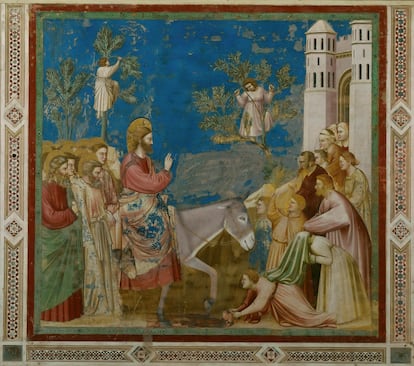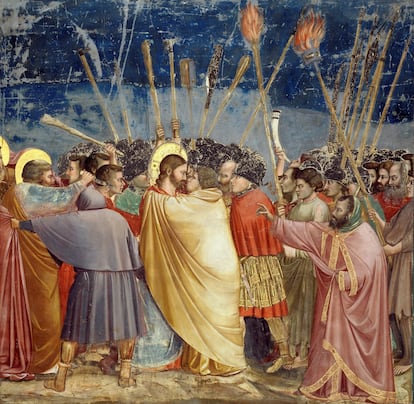In search of the historical Jesus: More questions than answers
Facts about the life of Jesus Christ are few, contradictory, and lost in the mists of legend

Jesus of Nazareth, whose death in Jerusalem is commemorated by Christians during Holy Week, was a historical figure who lived and died 2,000 years ago. For millions of believers, he is also the son of God, who rose on the third day, and the founder of a religion that spread throughout the Roman Empire in a relatively short period of time. Most experts believe in the historical existence of Jesus, although there are immense gaps in the knowledge about his life. The facts are scarce, sometimes contradictory, and, in many cases, lost in the mists of legend. Some experts even consider him a literary figure shaped by the four evangelists who wrote their texts decades after his death.
One of the greatest experts on the biblical and historical figure of Jesus was a journalist for this newspaper, Juan Arias, a former correspondent in Rome and Brazil, first editor of the literary supplement Babelia, readers’ advocate, theologian, a former priest who covered the Second Vatican Council, author of books such as Jesus, That Great Unknown, and one of the most beloved people in the EL PAÍS newsroom. Every year at Christmas and Easter, he wrote texts about Jesus full of wisdom and tolerance. He died last November at the age of 92, and many readers have been left orphaned by the humanity of his reflections.
In one of his articles, Juan Arias explained that “biblical scholars believe that, of all the things attributed to Jesus in the Gospels, only 12 phrases are literal,” including “no one is a prophet in his own land,” “render unto Caesar what is Caesar’s and unto God what is God’s,” and “it is harder for a rich man to be saved than for a camel to pass through the eye of a needle.”
“History or myth, legend or reality, the Jewish man known as Jesus has managed to endure for more than 2,000 years, not only as a religious fact, but as an unprecedented phenomenon, capable of seducing millions of people, believers or not,” Juan wrote in another text, in which he made it clear that the deepest mystery has nothing to do with his existence, or even with faith, but with a permanence that is due, in large part, to the genius of the anonymous authors of the Gospels.

The search for the historical Jesus seems inexhaustible, perhaps because following this path means, at its core, exploring the boundaries that separate faith from reason: although faith is above facts, even for millions of believers, the importance of a real Jesus is undeniable. Every year, new books are published that join the debate, some of which leave a profound mark, as was the case with The Invention of Jesus of Nazareth by Spanish Open University professor Fernando Bermejo Rubio, whose expanded 2023 edition continues to be sold in bookstores. There is also Heresy (2024), by historian Catherine Nixey, who has followed the entire documentary trail of Jesus to offer a far from complacent version of the character. Now, a new essay by Elaine Pagels, an American professor of the history of religions at Princeton University and one of the leading experts on the subject, Miracles and Wonder: The Historical Mystery of Jesus, has just been published in the United States, sparking heated discussions among critics.
The three books offer a fresh, informed, and critical look at existing documents and testimonies, their contradictions, and the windows they offer to try to glimpse a real person hidden behind the construction of a religious discourse or, conversely, the critique of this new religion. In other words, they all have a political agenda: in the case of the evangelists, to articulate a religion that could grow within the Roman Empire — hence why they blamed the Jews for his death, despite the fact that Jesus was Jewish and crucifixion was a Roman punishment — while the Romans rejected what they considered a potential danger to the stability of the empire.
This is how Pagels, in her latest work, describes her first steps, as a student, in the search for a real Jesus. “First, I learned that none of the accounts now called Gospels were written during Jesus’ lifetime. On the contrary, they were written anonymously, between 40 and 60 years after his death. I also discovered that none of the surviving first-century sources that mention Jesus are neutral. For while his devoted followers were writing Gospels, prominent members of the Roman elite were writing scathing attacks.”
The texts that shaped Christianity, and therefore the image of Jesus, present enormous contradictions. They do not agree even on his birth or the date of his death: Mark, Luke, and Matthew speak of one day and John of another. However, there is considerable textual and archaeological information about Palestine in the first century AD, allowing historians to anchor their arguments in a fairly solid historical context.

Non-Christian sources about Jesus, especially Jewish and Roman historians, are scarce and not even contemporary; but they are sufficient for the vast majority of researchers to consider his existence proven. Despite this, the most important ancient fragment that refers to Jesus, written by the first-century historian and politician Flavius Josephus, the so-called “Flavian testimony,” is considered a forgery by a considerable number of scholars. The text, from the year 93 AD, reads as follows: “Now there was about this time Jesus, a wise man, [if it be lawful to call him a man, for he was a doer of wonderful works, a teacher of such men as receive the truth with pleasure.] He drew over to him both many of the Jews, [and many of the Gentiles. He was the Christ]; and when Pilate, at the suggestion of the principal men amongst us, had condemned him to the cross, those that loved him at the first did not forsake him, for he appeared to them alive again the third day, [as the divine prophets had foretold these and ten thousand other wonderful things concerning him]; and the tribe of Christians, so named from him, are not extinct to this day.” (The fragments in brackets are the most problematic).
The first foundational text of Christianity is the Epistles of St. Paul, written in Greek two decades after the crucifixion. Of the 13 or 14 surviving letters — scholars disagree — only seven are considered authentic. And then there are the four Gospels. In his review of Pagels’ book in The New Yorker, Adam Gopnik summarizes the widely held view of the canonical Gospels. “Written in Greek some forty to sixty years after the Crucifixion is thought to have happened. These were composed somewhere far from Jerusalem, in a language that Jesus and his disciples would not have known, by writers who could not have been eyewitnesses. The books are attributed, in probable order of composition, to Mark, Matthew, Luke, and John.”
Nor can we speak of real authors, because they were only attributed to those names much later, in the second century. Beyond faith and history, the literary talent of those responsible for these texts is immense. Pagels points out as one of their greatest achievements their ability to transform a humiliating and shameful punishment in Ancient Rome — reserved for slaves, agitators who dared to confront the Empire, and renegades — “into proof of Jesus’ divine mission.”

The balance between these three figures — the real Jesus, the divine Jesus, and the literary Jesus — continues to spark controversy and discussion because, as Marc Bloch wrote, “Christianity is a religion of historians.” “Other religious systems may have based their beliefs and rituals on a mythology more or less external to human time. As their sacred books, Christians have history books, and their liturgies commemorate with their episodes the earthly life of a god,” continues the French researcher, murdered by the Nazis in World War II and founder of the Annales School, which completely changed the way we view the past.
Christianity is a religion of stories that, in the end, have prevailed over history. In her book, Pagels recalls the same mystery that marked so many of Juan Arias’ wonderful texts: “I can’t resist wondering not only who Jesus was, but also who he is. What intrigues me is the astonishing persistence of Jesus, both rediscovered and reinvented. How did the rabbi known as Jesus of Nazareth come to be imagined as the son of God enthroned in heaven alongside the Lord of hosts?” Two thousand years later, the answer to that question continues to shape the present.
Sign up for our weekly newsletter to get more English-language news coverage from EL PAÍS USA Edition
Tu suscripción se está usando en otro dispositivo
¿Quieres añadir otro usuario a tu suscripción?
Si continúas leyendo en este dispositivo, no se podrá leer en el otro.
FlechaTu suscripción se está usando en otro dispositivo y solo puedes acceder a EL PAÍS desde un dispositivo a la vez.
Si quieres compartir tu cuenta, cambia tu suscripción a la modalidad Premium, así podrás añadir otro usuario. Cada uno accederá con su propia cuenta de email, lo que os permitirá personalizar vuestra experiencia en EL PAÍS.
¿Tienes una suscripción de empresa? Accede aquí para contratar más cuentas.
En el caso de no saber quién está usando tu cuenta, te recomendamos cambiar tu contraseña aquí.
Si decides continuar compartiendo tu cuenta, este mensaje se mostrará en tu dispositivo y en el de la otra persona que está usando tu cuenta de forma indefinida, afectando a tu experiencia de lectura. Puedes consultar aquí los términos y condiciones de la suscripción digital.
More information
Archived In
Últimas noticias
ChatGPT fails the test: This is how it endangers the lives of minors
The late consecration of women artists in their 90s
The Florida Keys tourist paradise is besieged by immigration agents: ‘We’ve never seen anything like this’
The latest scam on WhatsApp behind the legal dream: using immigration status as bait
Most viewed
- Families demand repatriation of bodies of Colombians who died in Ukraine: ‘This war is a slaughterhouse for foreigners’
- The low-cost creative revolution: How technology is making art accessible to everyone
- Liset Menéndez de la Prida, neuroscientist: ‘It’s not normal to constantly seek pleasure; it’s important to be bored, to be calm’
- Christian Louboutin: ‘Young people don’t want to be like their parents. And if their parents wear sneakers, they’re going to look for something else’
- ‘El Limones’ and the growing union disguise of Mexican organized crime











































